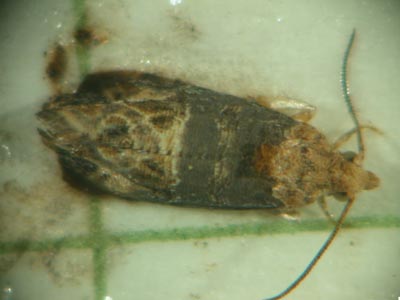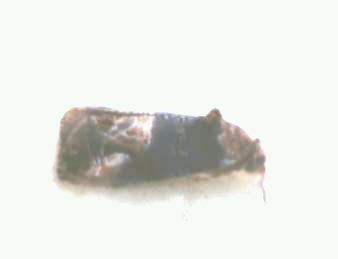

The larvae are creamy in color at first, turning green or gray-green and eventually nearly purple when mature, nearly 10 mm long. The first-generation larvae feed on blossoms or small berries. They leave silken strands where they have crawled, resulting in webbed clusters. One larva may injure several berries. Initially larvae feed externally on the small berry, but when fruit are 6-8 mm in diameter, larvae begin to enter and feed internally, making a small hole about a mm in diameter. Soon after larvae enter berries, winding dark tunnels are evident through the surface of the berry. After feeding for 3-4 weeks, each larva makes a semicircular cut in a leaf, folding and tying the flap around itself. The pupal stage is passed in mid to late July at this site. Adults emerge after 10-14 days, peaking in mid-August.
Third and fourth-generation eggs are
laid from late July into September on berries. A red spot develops
at the point of entry of the larva (Plate 10). Larvae tunnel into
the fruit, where they feed on pulp and seeds. This causes fruit to
shrivel and fall, and may lead to loss of most of the crop.
Berries may be webbed together and sticky with juice. Larvae of
this generation are more numerous than in the first generation.
These larvae drop to the ground where they pupate and overwinter
in leaves under the trellis. Two generations annually have been
recorded in Ohio and three in Ontario. Pennsylvania sites only 16
km apart have been shown to vary in the number of generations.
Work in Virginia indicates three to four generations, with a
possible fifth in some seasons. Populations of grape berry moth
may be monitored with a commercially available pheromone trap. A non-economic species
feeding on sumac, Episimus argutanus,
is also attracted to GBM pheromone traps, and may outnumber grape
berry moth in the traps. Furthermore, there is some overlap
in the pheromone blend of grape berry moth and redbanded
leafroller, an occasional grape pest; consequently, a redbanded
leafroller moth may occasionally turn up in a grape berry moth
trap. In the linked photo, GBM is on
the left, RBL is on the right. The relationship between trap
captures and fruit damage is strongly influenced by vineyard
surroundings. In vineyards surrounded by open terrain (cornfield
or pasture, etc.), trap numbers may be high but actual injury low.
In vineyards surrounded by woodland (with wild grapevines), trap
captures may be low, but accompanied by high levels of injury. In
a Mihigan study, pheromone traps were placed at varying heights up
to 30 ft.; GBM trap captures increased with height.
Prediction of egg deposition using degree day models has been
difficult.
A model developed for northern states
used degree days after bud break of a wild grape species to time
sprays. The grape species used in that model are not common
in Virginia, consequently a different approach is used. GBM
pheromone traps are placed at a wooded edge near the vineyard, and
monitored daily for biofix (first sustained capture of
adults). Sprays may be timed toward peach catch for the
generations: Spring generation 145 DD above a base of 50 degrees
F, 1st generation 720 DD, and second generation 1900 DD.
Recent research in Pennsylvania has centered on the initiation and termination of diapause. Diapause termination: The first adults appear in the spring at 266 degree-days above a threshold of 47degrees F (Celsius: 148 DD above 8.4 degrees C) (Tobin et al. 2002). Development of a complete generation requires 900 DD (Celsius: 500 DD). This can be divided into 763 for development from egg to adult, and 133 for mating and preovipositional behavior (Celsius: 424 and 74 DD, respectively) (Tobin et al. 2001). However, emergence is variable in this species. Tobin et al. (2002) found that after cold exposure, adults emerged 20-26 days after a return to warm temperature. But if pupae were not exposed to cold, individuals emerged within a month before or after the cold-treated insects. Therefore, in springs following mild winters, it may be difficult to accurately predict adult emergence.
Other recent Pennsylvania research has shown that the induction of diapause is determined by decreasing daylength when individuals are in the egg stage. For example at 15 hours photophase at oviposition, 0% of the individuals entered diapause, and hence the resulting adults would produce a further generation. At 14 hours 44 minutes, 25% entered diapause; at 14 h 30 min, 80% entered diapause, and at 14 h, 99% entered diapause. Control directed at larvae that will not enter diapause may contribute significantly to prevention of a late generation, close to harvest. Fifteen h occurred on 12 July in Pennsylvania. This must be determined at various latitudes. Since the longest daylength at 38N (Charlottesville) is 14 h 48 min on June 21 (solstice), verification of these models is desirable. Critical photophase values associated with given proportions of the population entering diapause are probably shifted accordingly. A daylength calculator is available on the web, as is a table with approximate daylength values (note that northern latitudes are presented after southern latitudes).
Researchers in New York have established a risk assessment system for grape berry moth. Factors that mitigate toward high risk are: history of high GBM injury, wooded vineyard margins, and prolonged snow cover. Low-risk factors are open vineyard settings and low historical incidence. However, this scheme was created for processing grapes; table and wine grapes were considered to be always at high risk. (See New York PDF)
High populations and damage have been seen in Virginia after consecutive mild winters. Substantial winter mortality occurs after several days of very cold temperatures (-6 to +5 degrees F).
More selective insecticides are now available for grape berry moth control, such as Intrepid 2F, Entrust SC, Delegate WG and Altacor 35WDG. Researchers in Arkansas have recommended spraying at 450-700 degree-days above a base of 50 degrees F after first male captures (biofix), and from 1250-1700 DD, and every 10 days from 2250 into September.
In addition to chemical control, mating disruption and cultural control are
useful in controlling grape berry moth. Mating disruption was formerly available for grape
berry moth through Pacific
Biocontrol (rope dispensers) and 3M
Canada (sprayable). A current product is SPLAT
GBM.
If
this pest has been troublesome, leaves may be raked and burned in
the fall. The soil beneath rows may be cultivated to bury
overwintering pupae. Soil from row centers should be piled beneath
vines about a month before harvest. In the spring, about two weeks
or more before bloom, this ridge is pulled back into the row
center and disked or plowed. An egg parasite, Trichogramma
minutum Riley, provides some biological control. However,
grape berry moth does not appear to be an optimal host, and
resulting adults have poor vigor and exhibit developmental
abnormalities (Nagarkatti et al. 2002). Inundative release
of insectary-produced Trichogramma may be a solution.
Until recently, this species was
known generally as Endopiza
viteana Clemens. The genus has been changed to Paralobesia because Endopiza was regarded as a
misspelling of Endopisa,
a synonym of Grapholita
(Isaacs pers. comm.).
References